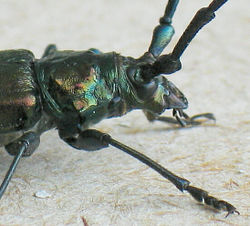This article has multiple issues. Please help improve it or discuss these issues on the talk page . (Learn how and when to remove these messages)
|
| Musk beetle | |
|---|---|
 | |
| Scientific classification | |
| Kingdom: | Animalia |
| Phylum: | Arthropoda |
| Class: | Insecta |
| Order: | Coleoptera |
| Suborder: | Polyphaga |
| Infraorder: | Cucujiformia |
| Family: | Cerambycidae |
| Genus: | Aromia |
| Species: | A. moschata |
| Binomial name | |
| Aromia moschata | |
The musk beetle (Aromia moschata) is a Eurasian species of longhorn beetle belonging to the subfamily Cerambycinae, tribe Callichromatini. Its name comes from the delicate musky smell it emits when menaced. The beetle has a shell with an iridescence tone that changes with the angle of view. It has a hard shell around the thorax with hard sharp spines.


